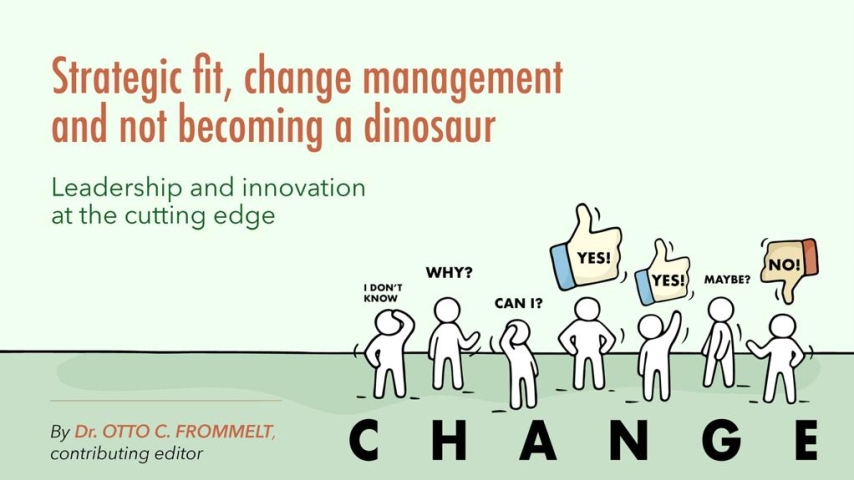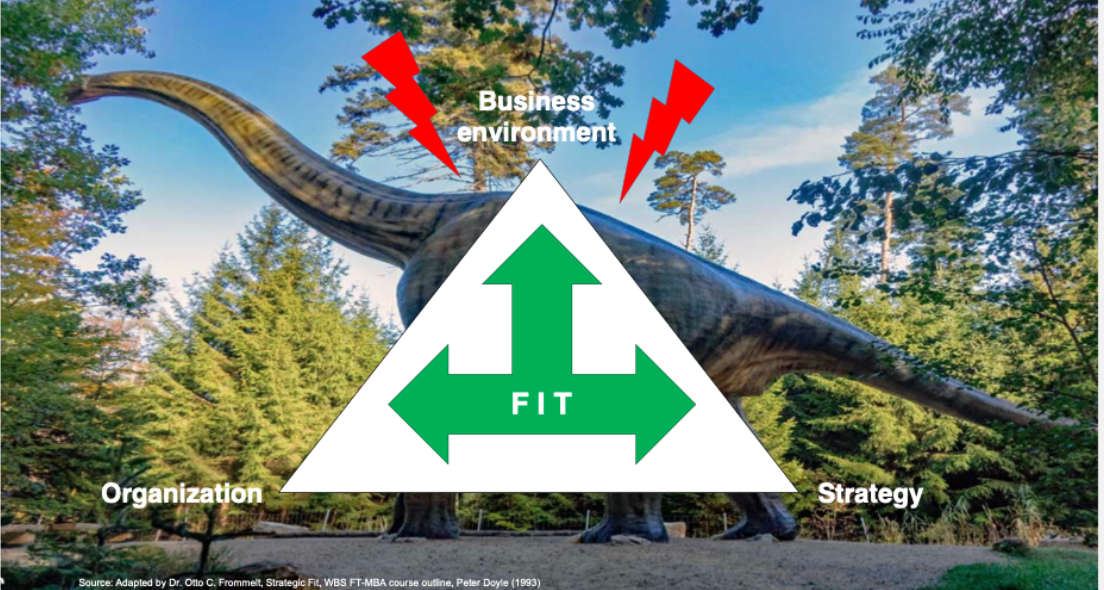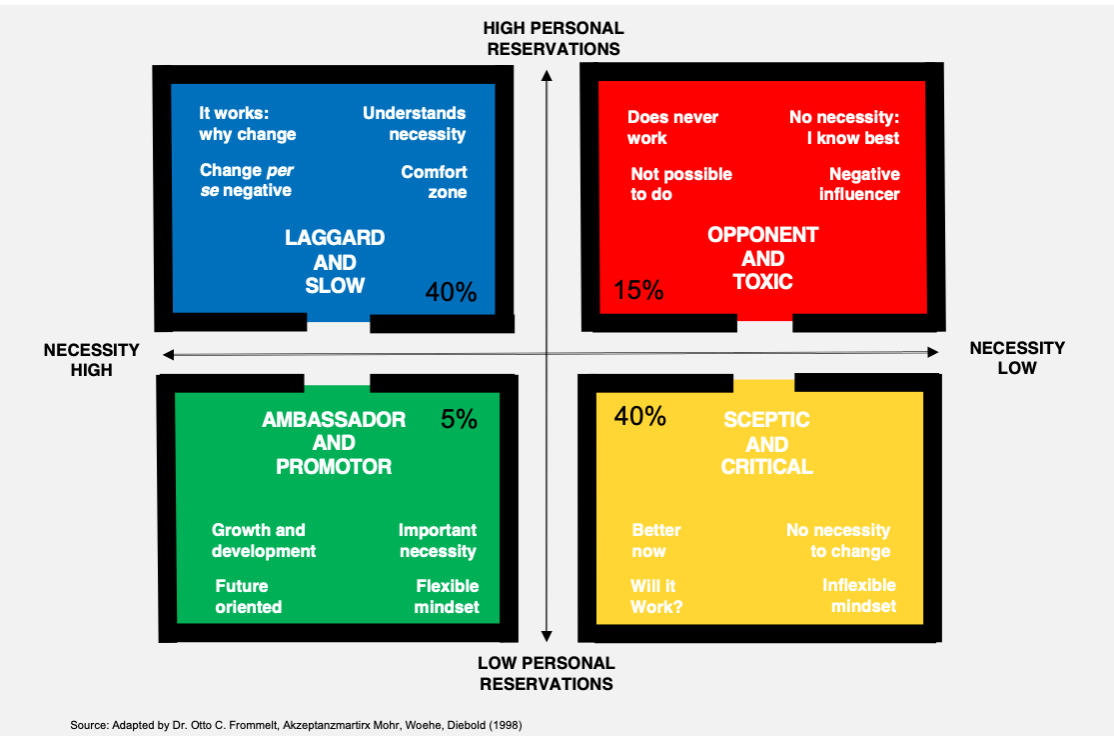
Anticipating the changing business environment, adapting the strategy and organization to create a fit, is more art than science, but critical to thrive and grow. How to manage change is key to success or failure of a company, organization and team. In this vein, leaders should be aware of pitfalls and hurdles that have to overcome as far as change management goes. It is important to sense and understand personal reservations and perception of necessity for co-workers and team: For, opponents can be toxic, while ambassadors can be promotors for change projects. Laggards and sceptics can significantly slow down a change process. The adoption matrix framework visualizes and conceptualizes who might approve or reject change.
Introduction
In order to be successful, it is crucial to have a fit among business environment, strategy and organization. Otherwise, the organization might become a dinosaur. To be “in fit” means to assess the business environment and adapt the company strategy and organization accordingly. Figure 1 presents the triangle for strategic fit. Strategy implementation is not static, but dynamic and, hence, needs to be changed and adapted. In relation to changes in organizations, the notion of a learning organization as advocated by Peter M. Senge in his book "The Fifth Discipline" remains insightful.
Figure 1: Strategic fit environment-strategy-organization

According to Senge (1990), a learning organization must master five disciplines:
- Personal mastery (self-development)
- Mental models
- Shared visioning
- Team learning
- Systems thinking
A learning organization is part of a change and transformation journey. What is also needed is change management competencies. But what is change management, and how can change be managed? This will be elaborated in the following and experiences shared. In addition, change challenges and opportunities will be outlined.
Change management
Change management is defined as facing new changes in ever shorter cycles and managing them successfully. However, leaders and co-workers often associate a change management process with fear and risks, which leads to resistance and often ultimately to the failure of the change projects. It is important to create a shared vision, and to align mental models amongst team and stakeholders. A robust change process includes co-creation of strategy, involvement, engagement and commitment of co-workers in the different stages of development and execution. Managing change and strategy implementation is probably one of the most difficult management tasks, as there are so many failures and wrongdoings that can occur on the way. But, where should particular attention be paid in order to be successful in change management?
Awareness of human behavior and adoption to change
Adoption theory examines the individual, as well as the choices an individual makes to accept or reject a particular innovation. In some cases, adoption is not only the choice to accept an innovation, but also the extent to which that innovation is integrated within the appropriate context. Introducing change is similar to attempting to climb Mount Everest, because only 5% of co-workers will understand and follow: i) the necessity to change and ii) have low personal reservations. These are the ambassadors and promoters of a change project and they will start to climb the mountain. What is more, 40% are laggards and slow to change. While they understand the necessity, it is preferred to stay in the comfort zone and underline that the current system works, ergo no change is really needed. Then, there is another cohort constituting 40%: The sceptics are critical as they do not identify the need for change. On top of this, their mindset is more inflexible, and they postulate that it is better within the current situation is. Lastly, there are about 15% of co-workers that are opponents, as they have high personal reservations to change and a low perception of necessity. These group can negatively influence the change process and create a toxic work environment that hinders any change. The adoption matrix (Figure 2) visualizes the four different types of co-workers and behavior.
Figure 2: Adoption matrix to change

Change management challenges
Having constituted the four individual types, it is to be considered how best to manage the situation. While involvement and communication in the change process is crucial, particular attention needs to be given to laggards and sceptics (Figure 2: blue/yellow box). They could be converted on the change journey. It is suggested to concentrate first on the laggards as the understand the necessity, and it may thus be possible to get them moving. The sceptics require more time and efforts to convince. The real challenge, however, are the opponents. An opponent of a change project can destroy it totally and therefore, it is of utmost importance to address the issue. It is proposed to have one-to-one discussions and outline the reasons for change. While this might not be enough, more change management tasks and involvement in the change process can be arranged. If there is no positive response, a personal coach could address the situation with the opponent and elaborate on potential avenues to change behavior. In some cases, team members might talk explicitly to the opponent to clarify the change process and its way forward. As an opponent to change can have a toxic influence for an organization culture and its co-workers, it is suggested, as last resort, to consider to part ways.
Change management opportunities
The opportunities to manage change and transformation are manifold: First and foremost, there is a bright and sustainable future ahead. Adapting the strategy to a changing business environment is a must to survive in the long-term. Change triggers learning and innovation for a company, organization and team. New business sectors and services can be conquered. New competences can be learned and implemented: Digitalization, blockchain technology, artificial intelligence, web3 and metaverse are some examples. In addition, the net zero endeavors and climate action trigger many new business models to generate sustainable robust growth for the future. Decentralized autonomous organizations (DAOs) are also new organizational models as well as holocratic structures for smart and lean working conditions. Last but not least, there is an emphasis on a circular business model and approach. What is more, a token economy encapsulated in a decentralized and trustful digital ecosystem with peer-to-peer (P2P) transactions to transfer value will significantly lower transaction costs. The new mindset to manage change will be agile, based on purpose and values.
Conclusion
If a company, organization or team does not want to become a dinosaur, it needs to address the changing business environment and adapt its strategy and organization. A learning organization, in combination with a robust change management process, is of paramount importance for long-term business success. However, human behavior to change needs to be considered and managed. Adaption with regards to personal reservations and perception of necessity must also be addressed in order to profit from the change management opportunities to their fullest extent.
Author: Dr. Otto C. Frommelt, MBA is Director at the National Road Office of the Principality of Liechtenstein. He has extensive international Senior Management expertise including board assignments. Multilingual with commercial sales, marketing, finance and leadership skills within automotive industry, non-profit organizations, public administration and innovative start-ups (Technology, Blockchain, Energy, Health sector, etc.). Currently he is a Governing Board Member at the Conference of European Directors of Roads (CEDR) as well as Member of Cardossier Association to manage the vehicle life cycle with blockchain technology. He is also a Business Angel, Blockchain Advisor, Keynote Speaker, international Scenario / Strategy Expert, Author and Mentor.

